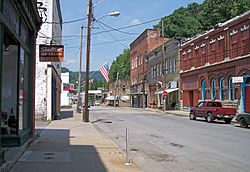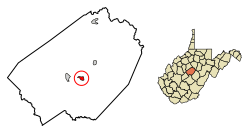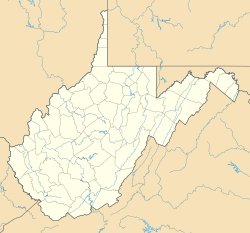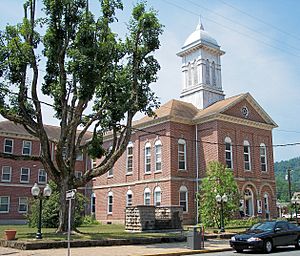Sutton, West Virginia facts for kids
Quick facts for kids
Sutton, West Virginia
|
||
|---|---|---|

Main Street in downtown Sutton in 2007
|
||
|
||

Location of Sutton in Braxton County, West Virginia.
|
||
| Country | ||
| State | ||
| County | Braxton | |
| Area | ||
| • Total | 0.82 sq mi (2.13 km2) | |
| • Land | 0.78 sq mi (2.01 km2) | |
| • Water | 0.04 sq mi (0.12 km2) | |
| Elevation | 840 ft (256 m) | |
| Population
(2020)
|
||
| • Total | 876 | |
| • Estimate
(2021)
|
859 | |
| • Density | 1,271.56/sq mi (491.23/km2) | |
| Time zone | UTC-5 (Eastern (EST)) | |
| • Summer (DST) | UTC-4 (EDT) | |
| ZIP code |
26601
|
|
| Area code(s) | 304 | |
| FIPS code | 54-78580 | |
| GNIS feature ID | 1555762 | |
Sutton is a small town in Braxton County, West Virginia, United States. In 2020, about 876 people lived there. Sutton is the main town, or county seat, of Braxton County. This means it's where the county government offices are located. The town is an important spot for travel in West Virginia. Major roads like Interstate 79 and U.S. Route 19 are close by.
Contents
A Look at Sutton's Past
Sutton was first settled in 1792 by Adam O'Brien. Later, in 1809, John D. Sutton made his home where Granny's Creek meets the Elk River. The town, first called Newville, was officially set up in 1835 as Suttonville. When Braxton County was created in 1836, the very first court meeting was held at John D. Sutton's house.
How Sutton Became a Travel Hub
Sutton was a key place for transportation. The Elk River could be used by boats. Also, a major road called the Weston and Gauley Bridge Turnpike passed through Sutton. This road connected other important routes. In 1853, a suspension bridge was built over the Elk River in Sutton, making travel even easier.
Railroads also came to Sutton. A train line connected Sutton to the West Virginia and Pittsburgh Railroad. Another line followed the Elk River and joined the Coal and Coke Railway.
Sutton During the Civil War
Because of its important location, Sutton was involved in the American Civil War. On September 5, 1861, about 5,000 Union soldiers took over the town. Later that year, General William Rosecrans and 10,000 Union troops stayed there. One of these soldiers was William McKinley, who later became a U.S. President. On December 29, 1861, Confederate soldiers burned down most of Sutton's downtown area.
Rebuilding and Growth
Sutton slowly rebuilt after the war. It stayed small until the local timber industry grew very big. Then, the town became a busy center for business. Many of the old banks, hotels, and shops in the Sutton Downtown Historic District were built between 1890 and 1920.
After this busy period, Sutton's growth slowed down again. In 1961, the Sutton Dam was built on the Elk River, just upstream from the town. This dam created Sutton Lake, which brought more tourists to the area.
Some important buildings in Sutton are listed on the National Register of Historic Places. These include the William Edgar Haymond House and the Old Sutton High School.
Where is Sutton Located?
Sutton is located at 38°39′52″N 80°42′37″W / 38.66444°N 80.71028°W. It sits right along the Elk River.
The town covers about 0.83 square miles (2.13 square kilometers). Most of this area is land, with a small part being water.
Sutton Lake: A Place for Fun
The Sutton Lake project was started to help control floods. Building the dam began in 1949 and finished in 1961. Today, the dam and Sutton Lake offer many fun activities. You can go boating, have picnics, play at playgrounds, and go camping. There's even a special fishing area for people with disabilities.
An interesting fact is that the exact geographic center of West Virginia is only four miles east of Sutton!
People of Sutton
Sutton has seen its population change over the years. In 1880, there were 279 people. The population grew to over 1,000 in the early 1900s. By 2020, the town had 876 residents.
Who Lives in Sutton?
According to the 2010 census, there were 994 people living in Sutton. Most residents were White (97.9%). A small number of people were African American, Native American, or Asian.
The average age in Sutton in 2010 was about 45 years old. About 18% of the people were under 18, and 20% were 65 or older. The town had a nearly even number of males and females.
Famous People from Sutton
- Dewey L. Fleming, a journalist who won a Pulitzer Prize, once lived in Sutton.
See also
 In Spanish: Sutton (Virginia Occidental) para niños
In Spanish: Sutton (Virginia Occidental) para niños





